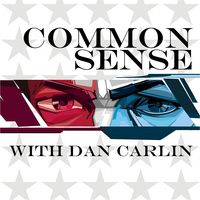Imaginary Worlds sounds like what would happen if NPR went to ComicCon and decided that’s all they ever wanted to cover. Host Eric Molinsky spent over a decade working as a public radio reporter and producer, and he uses those skills to create thoughtful, sound-rich episodes about science fiction, fantasy, and other genres of speculative fiction. Every other week, he talks with comic book artists, game designers, novelists, screenwriters, filmmakers, and fans about how they craft their worlds, why we suspend our disbelief, and what happens if the spell is broken. Imaginary worlds may be set on distant planets or parallel dimensions, but they are crafted here on Earth, and they’re always about us and our lived experiences.
https://www.imaginaryworldspodcast.org/
Gesamtlänge aller Episoden: 5 days 8 hours 5 minutes
recommended podcasts
Humans: New & Improved
When Graeme Manson started as a showrunner for BBC America's Orphan Black, he needed to create villains who were on the cutting edge of science, and believe that humans should take control of their own evolution. He found inspiration in the real-life movement of Transhumanists, who advocate using tech to improve our bodies, and live well beyond our natural life span. Transhumanist Natasha Vita-More says their vision of a posthuman future is not science fiction, even if it's inspired by it...
Economics of Thrones and Starships
Whether you're running the seven kingdoms of Westeros or flying to Mars -- you have to figure out how to pay for everything. Many economists are fans of sci-fi because those worlds take economics models to an extreme, especially when its comes to the issue of scarcity vs. abundance. Sarah Skwire looks at what happens when strawberries are precious like gold, or when hot Earl Gray tea can materialize instantly. And Matthew McCaffrey explains why we should all worry that "Winter is Coming...
Becoming Godzilla
This week's episode features another monster who comes from the sea and represents an existential threat -- but he's just so lovable. Journalist Dave Serchuk and graphic designer Jim Fazar both discovered Godzilla as kids and talk about his enduring appeal. But Jim went a step further and built a full body Godzilla suit. He and his brother Ron tell the story of how becoming Godzilla turned out to be much trickier than they anticipated...
When Cthulhu Calls
This week's episode is a radio drama, and a co-production with Jeff Emtman's podcast Here Be Monsters. I've been fascinated by the monster Cthulhu for a long time. The writer H.P. Lovecraft described Cthulhu as a gargantuan, aquatic being with tentacles on its mouth, and bat-like wings And yet, there is so much cute merchandise on the Internet which turns that green grotesque creature into an ironic meme...
Why They Fight
On the big screen this Spring, Batman will try to take down Superman, Iron Man is going to fight Captain America, and Daredevil will battle Punisher on Netflix. Cleary we are more interested in watching superheroes fight each other instead of the bad guys. The brawl between these characters isn't just about ego -- it taps into a larger conflict about personal ethics and the law...
Imagining Wonder Woman
Wonder Woman is finally going to make her cinematic debut in Batman v Superman: Dawn of Justice. Bringing her to the big screen has been a long and fraught process. She is a beloved character with a tricky backstory -- not just in the comics, but in real life too...
Noble Effort
In 2013, I co-produced this episode of 99% Invisible with Roman Mars about Maurice Noble, the artist who created many of the background (or "layouts") in Warner Brothers cartoons of the 1950s and '60s. Noble's work was revolutionary, but it got lost in the spotlight as Bugs Bunny, Daffy Duck and other Looney Tunes became cultural icons. But the next generation of artists recognized his genius and the society of "Noble Boys" (and girls) started to put his ideas into use at Pixar and elsewhere...
Dracula from Nebraska
We all know that novelist Bram Stoker based the character of Dracula off Vlad the Impailer, the Romanian prince who fought off the Turks -- or that's the urban legend. Stoker actually didn't research Vlad that much, or vampire folklore. So scholars have looked into his personal life to suss out Stoker's inspiration. Many think Dracula could've been based on his employer, the famous actor Henry Irving. But Professor Louis Warren of UC Davis has another theory...
Inside the Snow Globe
Tom Fontana is a TV writer and producer who worked on St. Elsewhere in the 1980s. The show was a pretty straightforward hospital drama, but Fontana had a mischievous streak -- and a soft spot for crossovers. So when he came up with a trick ending to the show, revealing the entire series had been the fantasy of an autistic boy named Tommy Westphall peering into his snow globe, Fontana had no idea that episode would lead to a unified theory of television...
The Expanded Universe
Warning: Spoilers ahead! When The Force Awakens came out, millions of fans flocked to the theaters to find out what happened to the characters in the 30 years since Return of the Jedi. But hardcore Star Wars fans knew what happened to them -- or they thought they did. LucasFilm had approved a series of books, comics and video games that filled in the gaps between the six Star Wars movies and beyond. Then Disney bought LucasFilm, and declared that canon of material (a.k.a...








































